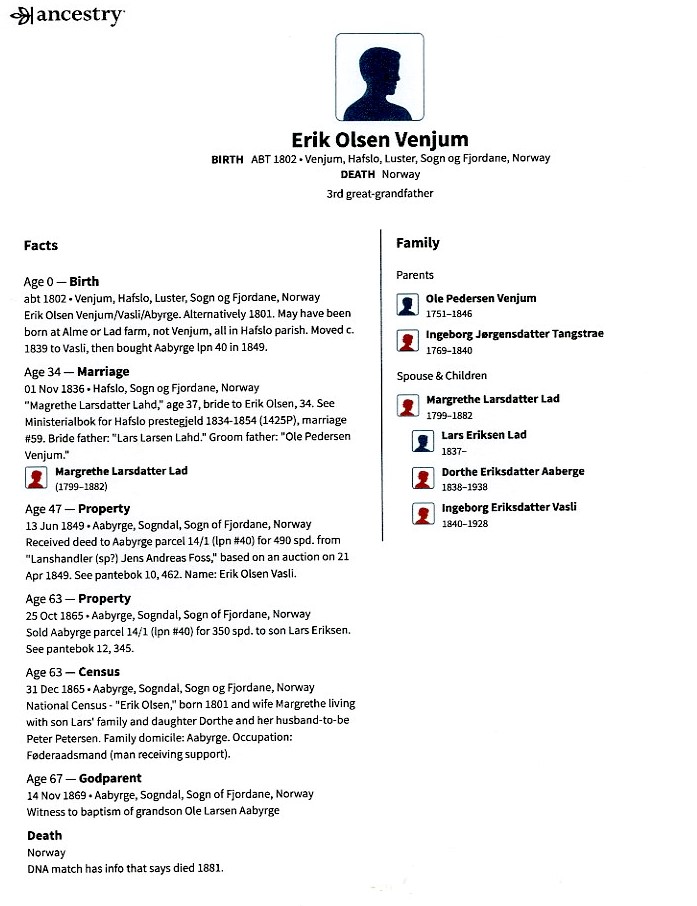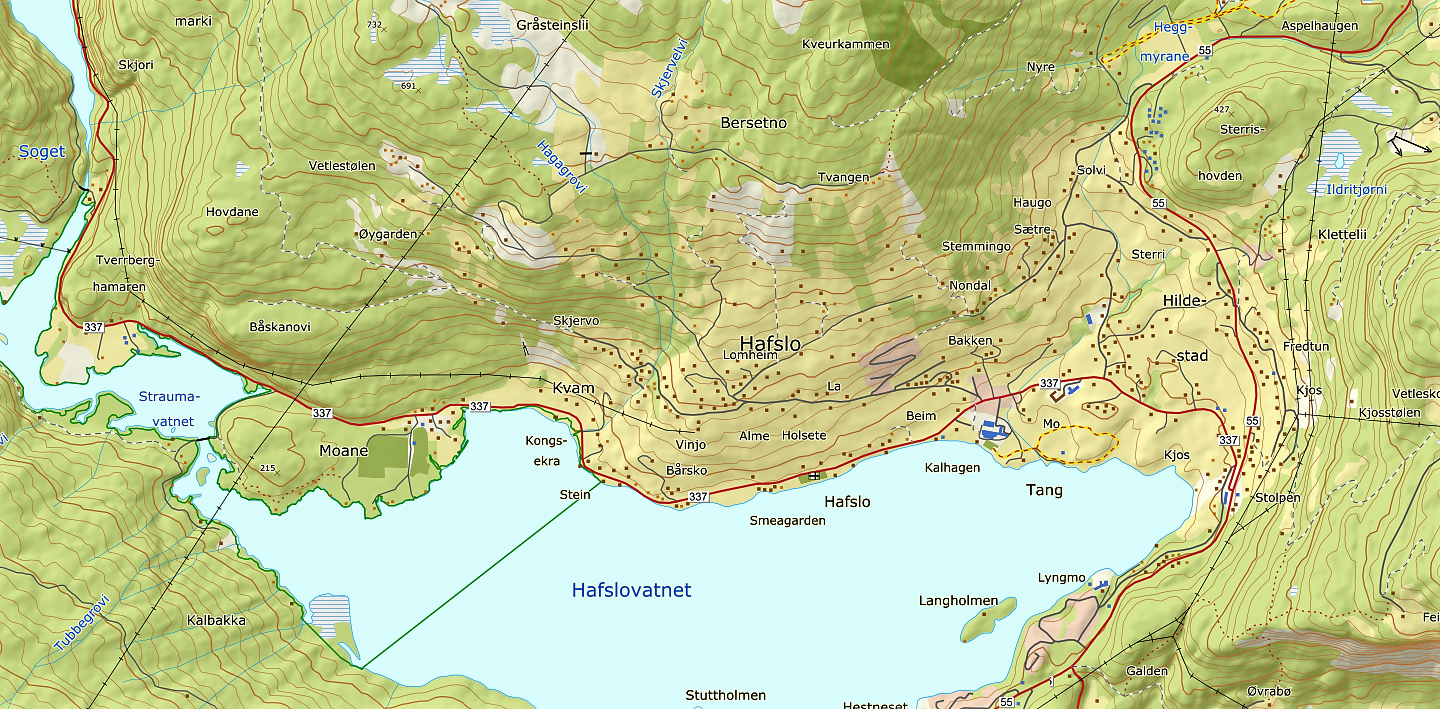The Hafslo Connection
“Nurse Betty,” an aunt of mine whose DNA I manage, recently forwarded an email she received from someone who matched her on FamilyTreeDNA. I will refer to him as “Mr. Anderson.” My aunt and Mr. Anderson share 118 centimorgans (cM) of DNA. That is in the range of 2nd to 4th cousin. I compared Mr. Anderson to everyone else in our family DNA project. It turns out he shares autosomal DNA with six family members. The amounts are listed below. For privacy reasons, I am using nicknames.
- Nurse Betty 118 cM – longest segment 53 cM on Chromosome #4
- Jelly Bean 79 cM – longest segment 49 cM on Chromosome #4
- Valhalla 77 cM – longest segment 53 cM on Chromosome #4
- Fjordster 65 cM – longest segment 20 cM on Chromosome #17
- JazzMa 73 cM – longest segment 49 cM on Chromosome #4
- Bizzy 80 cM – longest segment 49 cM on Chromosome #4
Neither BoyBoy nor I share an appreciable amount of DNA with Mr. Anderson.
What’s interesting is that five family members share at least 49 cM in one big segment on Chromosome 4 with Mr. Anderson (some have 53 cM, some have 49, but it’s the same area on the chromosome). That’s a big chunk. We don’t know what traits it includes but Fjordster, BoyBoy, and myself did not inherit it. Fjordster, instead, shares a 20 cM segment on Chromosome 17 which Nurse Betty also shares.
So, can we determine how we are related to Mr. Anderson? And, from that, can we determine from whom in our tree we inherited this section of Chromosome 4? The answer is yes to both questions.
Mr. Anderson and I compared family trees and were able very quickly to determine that our shared DNA is an Aaberge/Åbyrge connection from Sogndal, Norway.
The ancestor in my tree who came from Sogndal, Norway is my great grandmother, Bertha Aaberge Bonn (1865-1936). She was known in Norway as Bertha Petersdatter Aaberge. Bertha immigrated to America in 1883 at age 17 and initially lived in Minneapolis with her half-aunt Anna Lereim Swenson and Anna’s husband, Peter P. Swenson, sheriff of Hennepin County. Bertha attended millinery school in Minneapolis and eventually made her way to Montevideo, Minnesota, where she became the successful owner of a millinery shop. She married Bernt O. Bonn in 1892. To honor her memory and her life-long passion for education, her eldest son, Orville “Jack” Bonn (1896-1985), established in his will a college scholarship fund at Montevideo High School for one deserving graduating senior each year. Started in 1988, this continues today. The $10,000 Bertha Bonn Memorial Scholarship is the largest scholarship award presented.
So how is Bertha connected to Mr. Anderson, our DNA match? Bertha’s mother was Dorthe Eriksdatter Alme (1838-1938), who lived to be 100 years old. It turns out that Dorthe had a sister, and it is this sister, Ingeborg Eriksdatter Vassli (1840-1928) whose descendants lead to Mr. Anderson. I was previously unaware of this sister. Additional research on the Norway Digital Archives confirmed the relationship. Dorthe and Ingeborg’s parents were Eric Olsen Venjum (1802-1881?) and Margrethe Larsdatter Lad (1799-1882), both born and raised in Hafslo parish not far from Sogndal. Erik & Margrethe are the ancestors we share in common with Mr. Anderson.
The family group sheet below for Erik Olsen Venjum shows his two daughters Dorthe and Ingeborg as well as a son named Lars Eriksen who inherited the family farm. There may well have been other children of Erik & Margrethe who are not identified.
By the way, the reason for the different “last names” is that the Erik Olsen/Margrethe Larsdatter family moved several times. They were living at the Alme farm in Hafslo Parish in 1838 when Dorthe was born. Then they moved south to the Vasli farm near Sogndal before 1840; Ingeborg was born there on 3 June 1840. In 1849, Erik Olsen purchased a parcel of the Åbyrge farm and that’s where the family lived thereafter. After 1849, in other words, all of them used Åbyrge as their farm name (often spelled Aaberge).
Because Erik Olsen‘s father (Ole Pedersen Venjum) was listed in the 1801 census as a cotter (husmann) and not a landowner, it is impressive that Erik was successful enough later in life to purchase land and become a property owner at the age of 47. Totally speculative, but maybe Bertha inherited some of her business savvy and work ethic from her maternal grandfather.
My 2GG, Dorthe Eriksdatter, married Petter Pettersen Aaberge, (1835-1909), whose family lived on a different parcel of the Aaberge farm complex. As mentioned, their eldest daughter was Bertha, born Christmas Day 1865. Ingeborg Eriksdatter, Mr. Anderson’s ancestor, married Hans Arnesen Naversæter (1834-1910) in 1861 and had many children. Their family immigrated in 1867 and settled in Mower County, Minnesota after a short stint in Wisconsin. The featured image at the top of this post is a family photograph from around 1890, which Mr. Anderson kindly shared and allowed us to post. Ingeborg is the mother sitting in the middle. You can compare her image to that of her niece Bertha Bonn.
As a result of comparing family trees and confirming the familial relationship, we now know that Nurse Betty and her siblings are 3rd cousins to Mr. Anderson. I am a 3rd cousin, once removed. Third cousins inherit 74 cM of DNA on average, according to the Shared cM Project.[1]Blaine T. Bettinger, “The Shared cM Project – Version 3.0,” August 2017, www.thegeneticgenealogist.com, CC 4.0 Attribution License. Therefore, Nurse Betty has significantly more shared DNA with Mr. Anderson than average, Jelly Bean and Valhalla have about average, and Fjordster has less than average. Third cousins, once removed, share 48 cM on average. Both Bizzy and JazzMa have significantly more than average DNA with Mr. Anderson. BoyBoy and I may still share some DNA with him but, if so, it’s too low to show up in our match lists. It’s certainly less than average anyway.
We can also now say with some confidence that the DNA shared with Mr. Anderson came from Bertha Bonn’s maternal grandparents: Erik Olsen Venjum and Margrethe Larsdatter Lad. They ended up living on the Abyrge farm in Sogndal parish, but were born and raised in Hafslo parish. Erik’s ancestors and Margrethe’s ancestors both resided in the Hafslo area for two generations previously, at least. Therefore, when we look at Bertha Bonn’s ancestry, we have to divide it into two distinct lines from separate geographic locations. The ancestry of her father (Peter Petersen Aaberge) is almost exclusively situated in Sogndal parish (including farms such as Vikheim, Kvam, and Gorvin as well as Åbyrge), while the ancestry of her mother (Dorthe Eriksdatter Alme) is situated in Hafslo parish.
Here’s a map showing the region involved. The villages of Sogndal (Sogndalsfjøra) and Hafslo are 11 miles apart. The brown dots indicate individual farms. You can see the Åbyrge farm located on the ridge just above the village of Sogndal. Lake Hafslo (Hafslovatnet) is north of Sogndal about 10 miles. On its north side is a rich farming area which I’ve circled in blue ink. Notice the profusion of brown dots. This is the neighborhood where Erik Olsen’s family came from.
Here’s a closer view of Lake Hafslo and the farms on its north side. You can see the Alme, Lad and Venjum farms all quite close to one another. On this map, Lad is spelled La and Venjum is spelled Vinjo.
I found a great photograph online of Hafslo. The view is southeast. The body of water in the foreground is Lake Hafslo; the body of water in the distance is Lustrafjord, a branch of Sognefjord. The line of farmhouses in the front center of the photograph is exactly where our Hafslo ancestors lived. I don’t think we can pick them out specifically, partly because there is a tree blocking some of the view, but this perspective looks straight down the hill at the Lad, Alme, and Venjum farms, among others.

View of Lake Hafslo, Norway
I look forward to experiencing Hafslo in person when we visit Norway in June. We are staying at least one night in the historic Walaker Hotel in Solvorn, which is on the other side of the isthmus in this picture.
References
| ↑1 | Blaine T. Bettinger, “The Shared cM Project – Version 3.0,” August 2017, www.thegeneticgenealogist.com, CC 4.0 Attribution License. |
|---|








